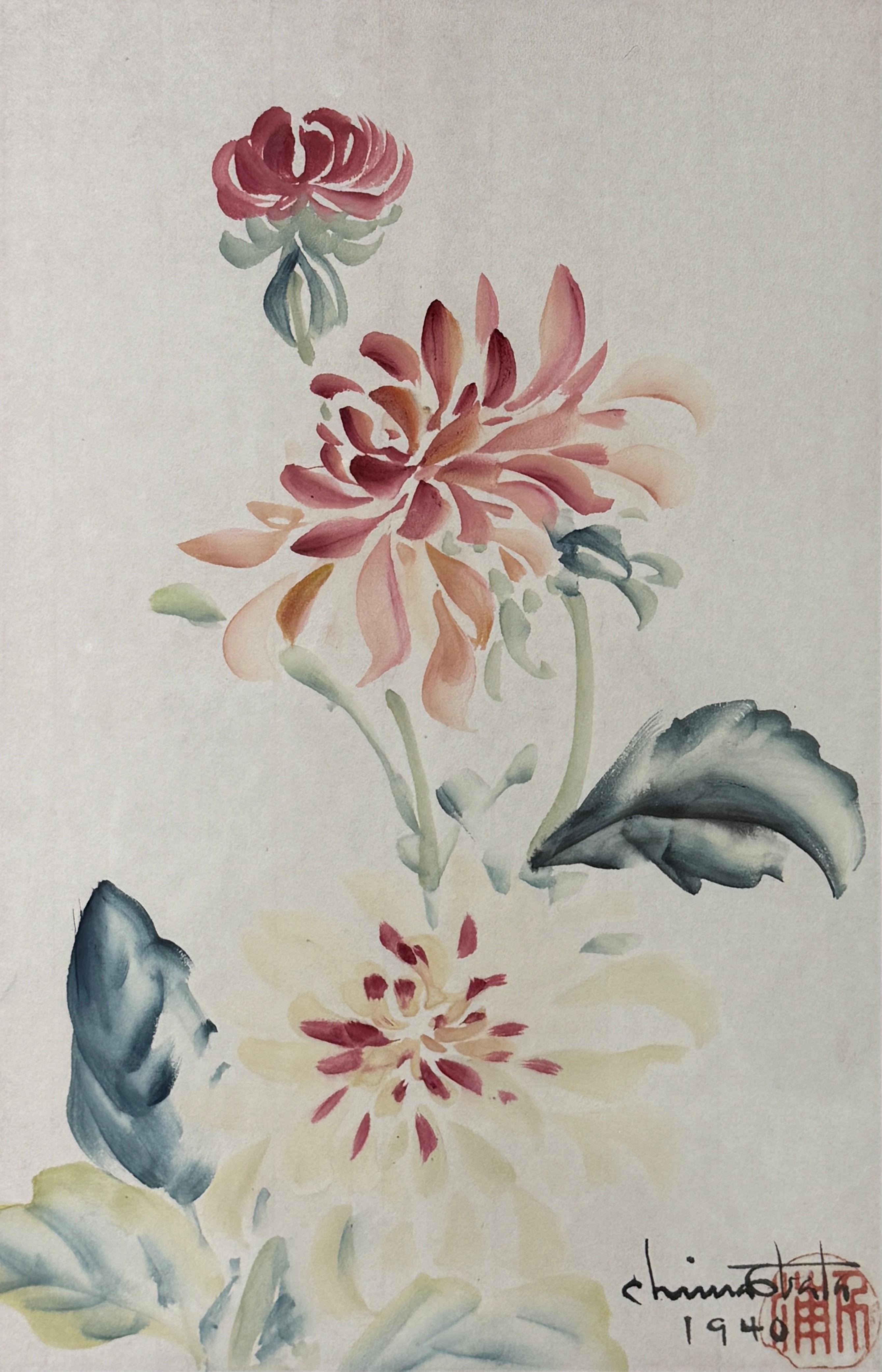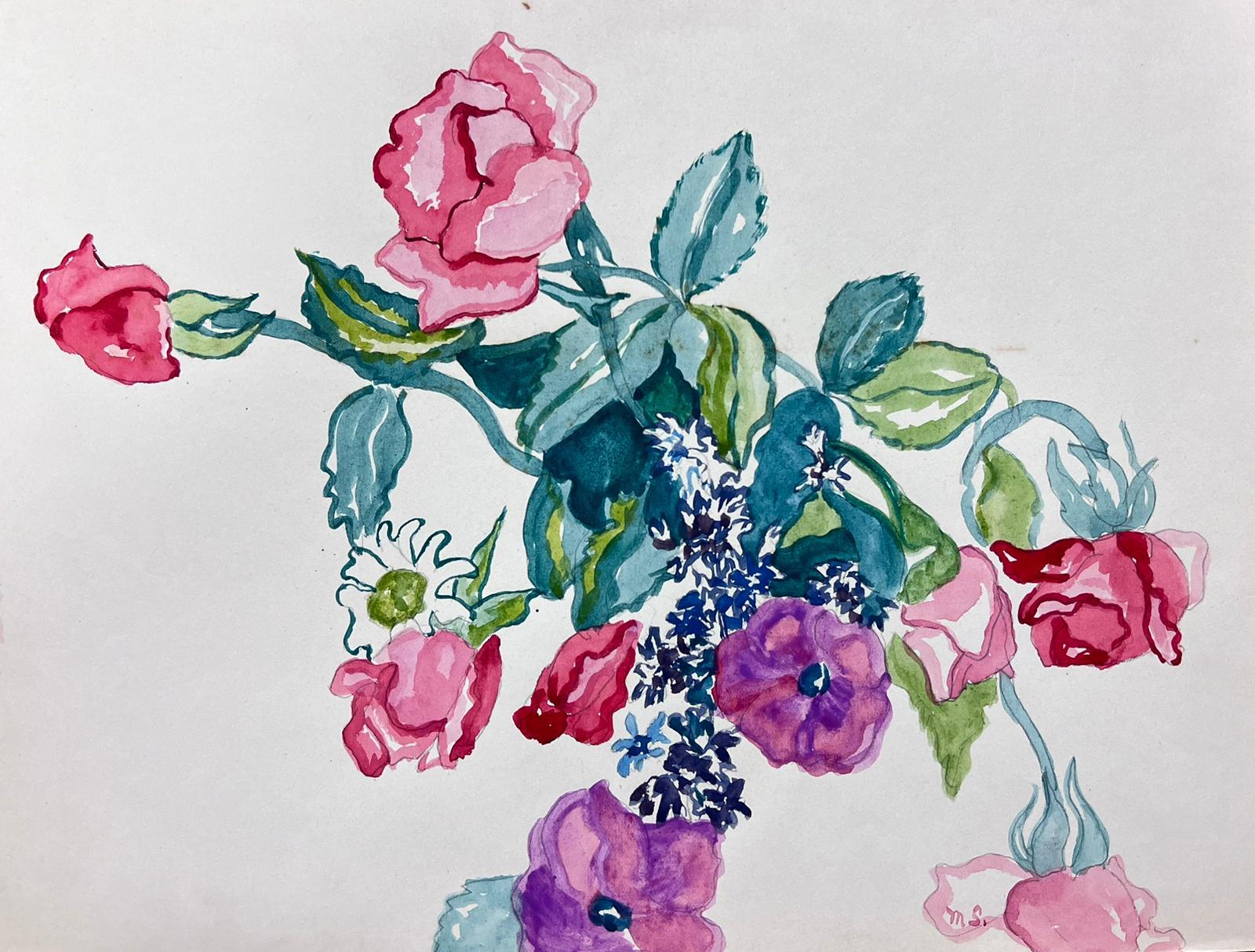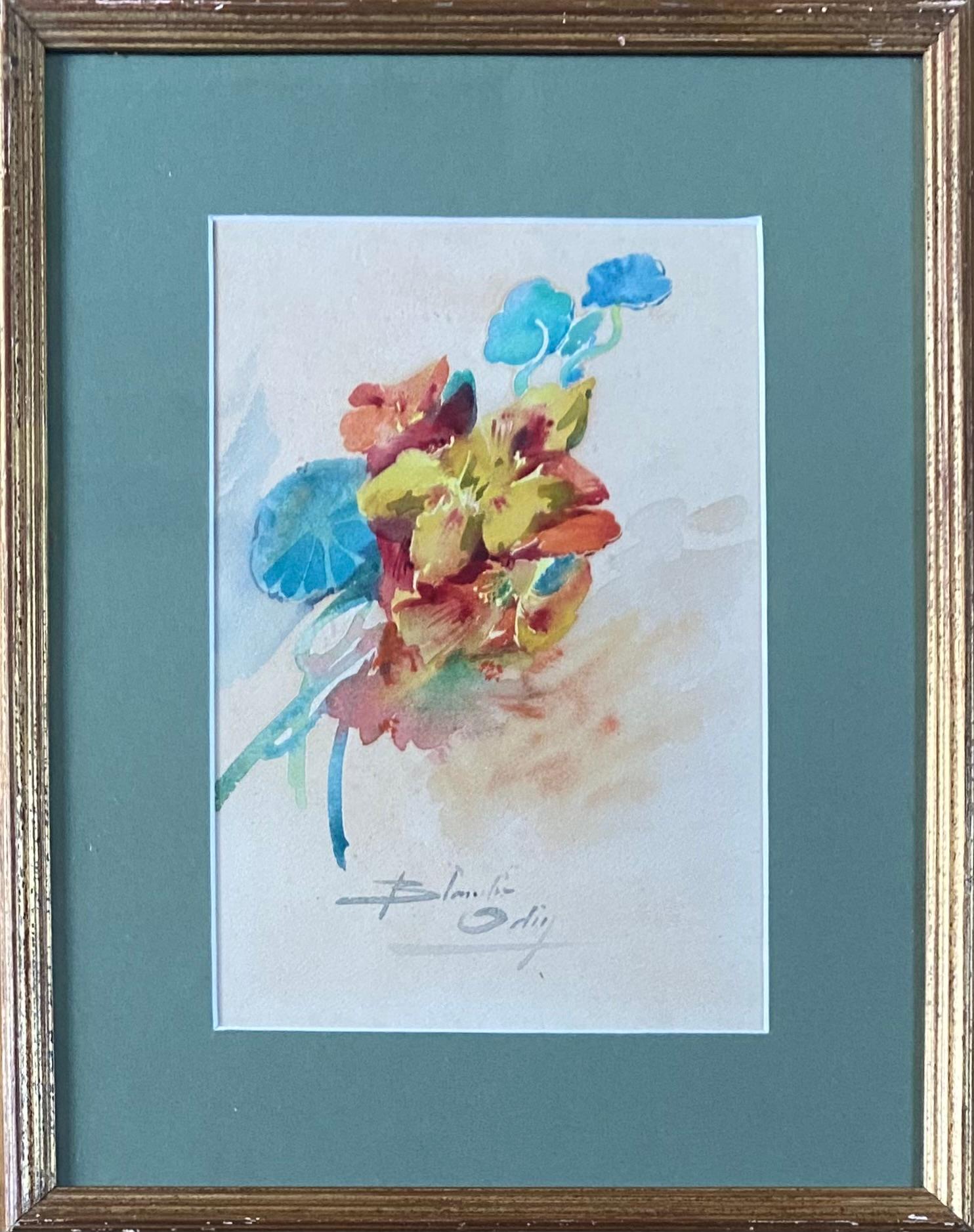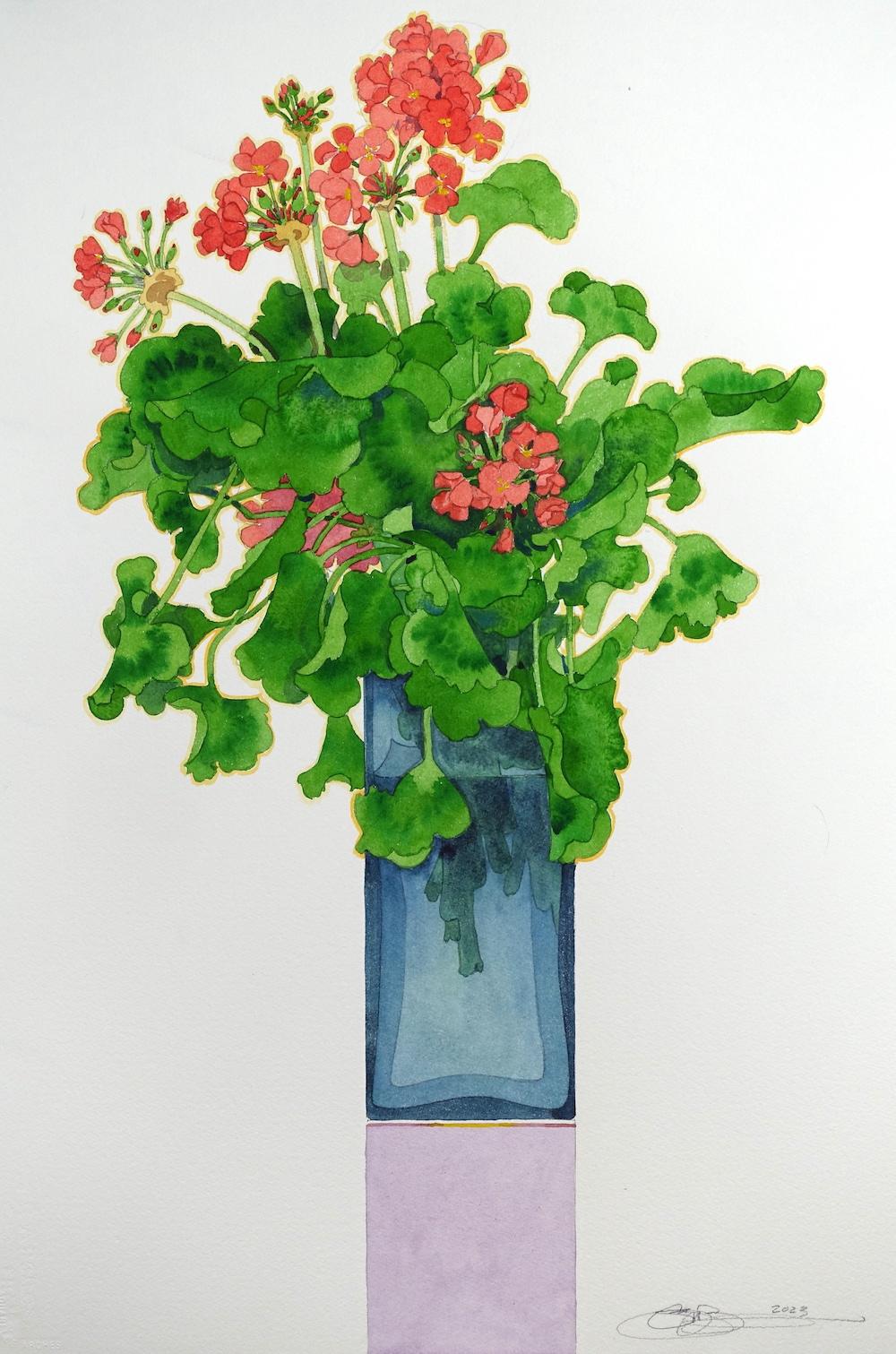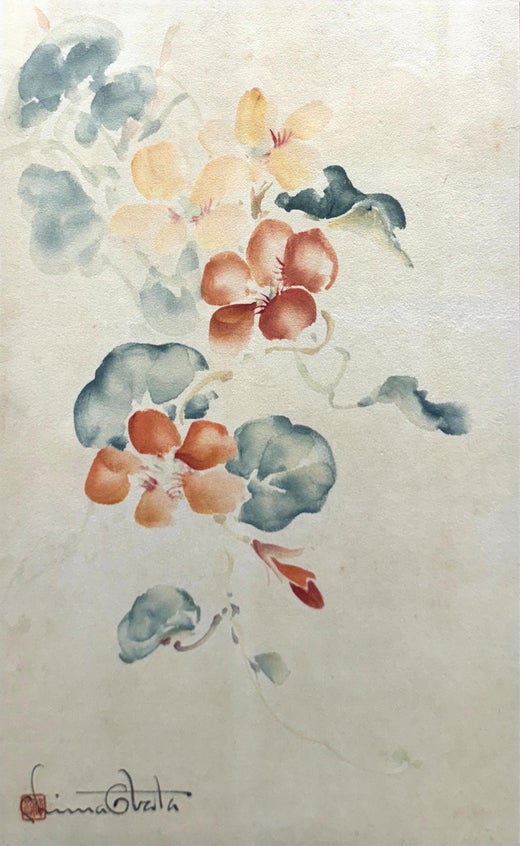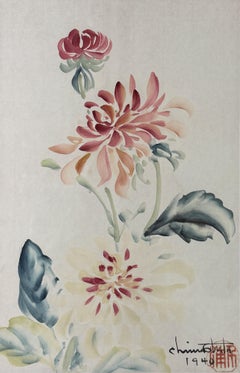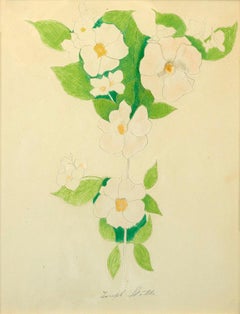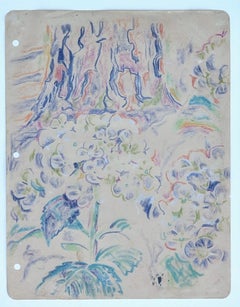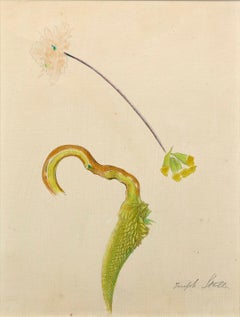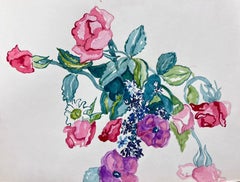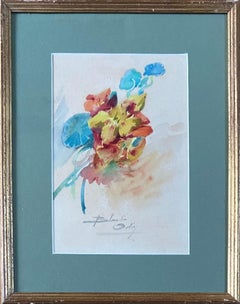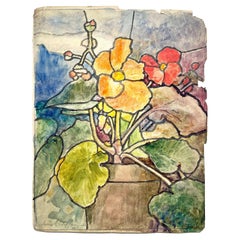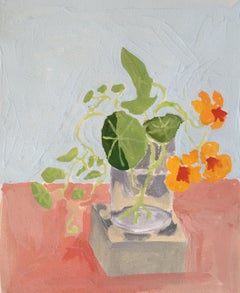Items Similar to "Nasturtiums" Chiura Obata, Japanese American, Red and Blue Delicate Flowers
Want more images or videos?
Request additional images or videos from the seller
1 of 11
Chiura Obata"Nasturtiums" Chiura Obata, Japanese American, Red and Blue Delicate Flowerscirca 1940
circa 1940
$4,500
£3,461.70
€4,018.05
CA$6,346.07
A$7,108.67
CHF 3,733.73
MX$86,439.15
NOK 47,281.22
SEK 44,882.59
DKK 29,988.26
About the Item
Chiura Obata
Nasturtiums, circa 1940
Signed and stamped lower left
Watercolor on paper
15 x 9 5/8 inches
Born in the Okayama prefecture of Japan, Chiura Obata was adopted by his uncle, an artist. As a child he was trained in ink painting, and at 14 he was apprenticed to the painter Murata Tanryo in Tokyo. He also studied with Kogyo Terasaki and Goho Hasimoto.
In 1903, Obata moved to San Francisco and began working as an illustrator for The New World and The Japanese American, two of the city's Japanese newspapers. He also did work as a commercial designer. Obata helped establish the East West Art Society in San Francisco in 1921, which sought to promote cross-cultural understanding through art. This goal was reflected in his embrace of the Nihonga style, which fused traditional Japanese sumi-e ink painting with the conventions of western naturalism.
He spent much of the 1920s painting landscapes throughout California, and among his favorite subjects were mountain landscapes. In 1927, he visited Yosemite and the Sierra Nevada, creating over a hundred paintings and sketches of the high country. Obata stayed in the USA until the death of his father in 1928.
Between 1928 and 1932, he worked in Tokyo as a painter and transformed his California landscape watercolors and sketches into a portfolio of 35 woodblock prints titled World Landscape Series - America, perhaps his most famous work. Obata's landscapes reveal his intensely personal and poetic vision of "Great Nature", a vision grounded in an underlying Zen philosophy of selflessness that accepts the insignificance of human affairs in relation to the timeless forces of nature.
In 1932 Obata Chiura returned to the U.S., and began work as an art instructor at the University of California, Berkeley.
In April, 1942, Obata Chiura and his wife Haruko were among the more than 100,000 Japanese Americans who were moved from their homes along the West coast into ten relocation camps. He was first sent to Tanforan. In September, 1942, he was moved to the Topaz, Utah, internment camp. During his internment in different camps, the artist made about hundred sketches and paintings until his release in 1945. The book, Topaz Moon, edited by his granddaughter Kimi Kodani Hill, is a documentation of his detention period and the works of art that he created during this time. While confined at Topaz, he organized and acted as Director for the Topaz Art School for the 8,000 Japanese Americans in the camp. The school had 16 artist instructors who taught 23 subjects to over 600 students. Obata's artwork from this time serves as a visual diary of the internees' daily life, and also as a powerful and lasting testament to the perseverance of the human spirit when confronted by prejudice.
In 1943, he was released from Topaz, and moved with his family to St. Louis, where he found work with a commercial art company. When the military exclusion ban was lifted in 1945, he was reinstated to his position at the University of California, where he stayed until his retirement in 1954. Obata was a popular professor, and played a pivotal role in introducing Japanese art techniques and aesthetics that became one of the distinctive characteristics of the California Watercolor School.
After his retirement he continued to paint, sketch and travel through the American countryside. In 1965 he received an order from the Japanese Emperor for promoting cultural exchange between the United States and Japan.
Chiura Obata died at the age of 90.
- Creator:Chiura Obata (1885 - 1975, Japanese)
- Creation Year:circa 1940
- Dimensions:Height: 22.5 in (57.15 cm)Width: 16.5 in (41.91 cm)
- More Editions & Sizes:Unique workPrice: $4,500
- Medium:
- Movement & Style:
- Period:
- Condition:
- Gallery Location:New York, NY
- Reference Number:1stDibs: LU1841216217482
Chiura Obata
Chiura Obata ranks among the most significant California-based artists and Japanese American cultural leaders of the last century. Born in Okayama, Japan, Obata immigrated to San Francisco in 1903. By then, he was integrating Western practices into his art-making, and continued experimenting with new styles and methods throughout his seven-decade career. Today Obata is best known for majestic views of the American West, sketches based on hiking trips to capture what he called “Great Nature.” In 1903, Obata moved to San Francisco and began working as an illustrator for The New World and The Japanese American, two of the city's Japanese newspapers. He also did work as a commercial designer. Obata helped establish the East West Art Society in San Francisco in 1921, which sought to promote cross-cultural understanding through art. This goal was reflected in his embrace of the Nihonga style, which fused traditional Japanese sumi-e ink painting with the conventions of western naturalism. He spent much of the 1920s painting landscapes throughout California, and among his favorite subjects were mountain landscapes. In 1927, he visited Yosemite and the Sierra Nevada, creating over a hundred paintings and sketches of the high country. Obata stayed in the USA until the death of his father in 1928. In 1932 Obata Chiura returned to the U.S., and began work as an art instructor at the University of California, Berkeley. In April, 1942, Obata Chiura and his wife Haruko were among the more than 100,000 Japanese Americans who were moved from their homes along the West coast into ten relocation camps. He was first sent to Tanforan. In September, 1942, he was moved to the Topaz, Utah, internment camp. During his internment in different camps, the artist made about hundred sketches and paintings until his release in 1945. While confined at Topaz, he organized and acted as Director for the Topaz Art School for the 8,000 Japanese Americans in the camp. Obata's artwork from this time serves as a visual diary of the internees' daily life, and also as a powerful and lasting testament to the perseverance of the human spirit when confronted by prejudice. In 1943, he was released from Topaz, and moved with his family to St. Louis, where he found work with a commercial art company. When the military exclusion ban was lifted in 1945, he was reinstated to his position at the University of California, where he stayed until his retirement in 1954. Obata was a popular professor, and played a pivotal role in introducing Japanese art techniques and aesthetics that became one of the distinctive characteristics of the California Watercolor School. After his retirement he continued to paint, sketch and travel through the American countryside. In 1965 he received an order from the Japanese Emperor for promoting cultural exchange between the United States and Japan. A retrospective of his work was organized by the Smithsonian American Art Museum in 2019-2020.
About the Seller
5.0
Platinum Seller
Premium sellers with a 4.7+ rating and 24-hour response times
Established in 2022
1stDibs seller since 2022
115 sales on 1stDibs
Typical response time: <1 hour
- ShippingRetrieving quote...Shipping from: New York, NY
- Return Policy
Authenticity Guarantee
In the unlikely event there’s an issue with an item’s authenticity, contact us within 1 year for a full refund. DetailsMoney-Back Guarantee
If your item is not as described, is damaged in transit, or does not arrive, contact us within 7 days for a full refund. Details24-Hour Cancellation
You have a 24-hour grace period in which to reconsider your purchase, with no questions asked.Vetted Professional Sellers
Our world-class sellers must adhere to strict standards for service and quality, maintaining the integrity of our listings.Price-Match Guarantee
If you find that a seller listed the same item for a lower price elsewhere, we’ll match it.Trusted Global Delivery
Our best-in-class carrier network provides specialized shipping options worldwide, including custom delivery.More From This Seller
View All"Dahlias" Chiura Obata, Japanese American, Red and Blue Delicate Floral Work
By Chiura Obata
Located in New York, NY
Chiura Obata
Dahlias, 1940
Signed, dated and stamped lower right
Watercolor on paper
15 x 9 5/8 inches
Born in the Okayama prefecture of Japan, Chiura Obata was adopted by his uncle, an artist. As a child he was trained in ink painting, and at 14 he was apprenticed to the painter Murata Tanryo in Tokyo. He also studied with Kogyo Terasaki and Goho Hasimoto.
In 1903, Obata moved to San Francisco and began working as an illustrator for The New World and The Japanese American, two of the city's Japanese newspapers. He also did work as a commercial designer. Obata helped establish the East West Art Society in San Francisco in 1921, which sought to promote cross-cultural understanding through art. This goal was reflected in his embrace of the Nihonga style, which fused traditional Japanese sumi-e ink painting with the conventions of western naturalism.
He spent much of the 1920s painting landscapes throughout California, and among his favorite subjects were mountain landscapes. In 1927, he visited Yosemite and the Sierra Nevada, creating over a hundred paintings and sketches of the high country. Obata stayed in the USA until the death of his father in 1928.
Between 1928 and 1932, he worked in Tokyo as a painter and transformed his California landscape watercolors...
Category
1940s Modern Still-life Drawings and Watercolors
Materials
Paper, Watercolor
"Flowers" Joseph Stella, Vibrant Modernist Flower Composition on Paper
By Joseph Stella
Located in New York, NY
Joseph Stella
Flowers
Signed lower center
Crayon and pencil on paper
13 1/4 x 10 1/4 inches
Stella was born June 13, 1877 at Muro Lucano, Italy, a mountain village not far from Nap...
Category
Early 20th Century Modern Figurative Drawings and Watercolors
Materials
Paper, Crayon, Pencil
"Hydrangeas, " Walter Inglis Anderson, Mississippi Southern Illustrator, Flowers
Located in New York, NY
Walter Anderson ( American, 1903 - 1965)
Hydrangeas, circa 1950
Mixed media on paper
11 x 8 1/2 inches
Provenance:
Luise Ross Gallery, New York
Private Collection, New Jersey
Acquired from the estate of the above, 2021
Walter Anderson firmly believed that quality art was an important part of life and should be made available to everyone. As he said, "There should be simple, good decorations, to be sold at prices to rival the five-and-ten." Noticing that only poor quality art was available in stores and little was available for children, he resolved to make art which could be reproduced easily and sell inexpensively — linoleum block prints. This technique enabled him to provide affordable, quality art.
The technique of linoleum block printing is a simple concept; however, it requires much skill and talent to actually produce memorable art. Anderson purchased surplus "battleship linoleum," thicker than ordinary linoleum with a burlap backing for better support, to create his blocks. During the mid-1940s, he created almost 300 linocuts working in the attic of the sea-side plantation house, Oldfields, his wife's family home in Gautier. Masses of linoleum chips accumulated at the foot of the attic stairs as he often worked night and day. He began with sketching out a design directly on the linoleum. Once he had carved the image into the surface, he used the back of faded, surplus stock wallpaper that a friend sent him, laying long strips on top of the inked linoleum. A roller made of sewer pipe filled with sand served as his press. When the print was completed, he often colored it by hand with bold strokes and vivid colors. The prints were sold at Shearwater Pottery, the family business, for a mere dollar a foot.
But "what about a well-designed fairy tale for a child's room?" he asked himself. Since there was a lack of affordable art for children, much of his work with linoleum blocks focused on subjects for children. He depicted fables and fairy tales ranging from Arabian Nights, to Germany and the Grimm Brothers' Rapunzel, to the French story of The White Cat, to the Greek tales such as Europa and the Bull, and to tales from China, India, and other cultures. Anderson also created "mini" books featuring the alphabet and Robinson Cat. The blocks are not only alive with the story being depicted, but they are also filled with designs taken from Best-Maugard's Method for Creative Design. Swirls, half-circles and zig-zag lines fill every available space on the linoleum block making them come alive and capture their audience.
But fairy tales, children's verses and the "mini" books, consisting of about 90 blocks, were not the sole subject of Anderson's linoleum block prints. In total, he created approximately 300 linoleum blocks with subjects ranging from coastal flora and fauna, coastal animals, and sports and other coastal activities. Anderson even created linoleum blocks to be used to print tablecloths and clothing, some worn by his own children. Color and subjects of the linoleum block prints were not the only things that got them noticed.
In 1945 when Anderson was creating these prints, the standard size of linoleum block prints was only 12 by 18 inches. These small dimensions were due to the common size of the paper available and the restrictions made by national competitions. Since Anderson used wallpaper...
Category
Mid-20th Century American Modern Landscape Paintings
Materials
Paper, Crayon
"Tropical Flower with Azalea" Joseph Stella, circa 1919 Academic Azalea
By Joseph Stella
Located in New York, NY
Joseph Stella
Tropical Flower with Azalea, circa 1919
Signed lower right
Silverpoint and crayon on paper
Image 10 3/4 x 8 1/4 inches
Sheet 11 x 12 1/4 inches
Stella was born June 1...
Category
Early 20th Century Modern Figurative Drawings and Watercolors
Materials
Paper, Watercolor
"Flowers" Mary Abbott, Colorful Floral Still Life, Female Abstract Expressionism
By Mary Abbott
Located in New York, NY
Mary Abbott
Flowers, circa 1950
Signed lower left
Pastel on paper
30 x 22 1/4 inches
Provenance:
Aaron Galleries, Glenview, Illinois
Among the early exponents of Abstract Expressio...
Category
1950s Abstract Still-life Paintings
Materials
Paper, Pastel
"Tulips" Daphne Mumford, Bright and Colorful Floral Diptych
Located in New York, NY
Daphne Mumford
Tulips
Signed lower right, titled on each stretcher
Oil on canvas, diptych
24 x 74 inches
Daphne Mumford studied at the Skowhegan School of Painting in 1952; the Chel...
Category
Late 20th Century Still-life Paintings
Materials
Canvas, Oil
You May Also Like
Vibrant Watercolor Floral Composition with Roses and Wildflowers
Located in Cirencester, Gloucestershire
Vibrant Watercolor Floral
original watercolour painting on artist paper
by Marjorie Schiele (1913-2008) *see notes below
piece of paper is 9.5 x 12.5 inches
In good condition
proven...
Category
Early 20th Century American Impressionist Still-life Paintings
Materials
Watercolor
Throw of flowers, nasturtiums
Located in PARIS, FR
Blanche ODIN
Troyes 1865 - Bagnères-de-Bigorre 1957
Throw of flowers, nasturtiums
Watercolor on paper
Signed lower right
25 x 16.5 cm sheet
37 x 30.5 cm frame
Category
Late 19th Century French School Still-life Drawings and Watercolors
Materials
Watercolor
"Nasturtium, " Watercolor by Louis Comfort Tiffany for Stained Glass Window, '21
By Louis Comfort Tiffany
Located in Philadelphia, PA
Beautifully painted in vivid tones of yellow-orange, mossy green, warm red and deep blue -- echoing the rich tones of the stained glass he employed -- this rare and gorgeous watercolor by Louis Comfort Tiffany was clearly painted to inspire and guide the design of one of his stained glass windows featuring the nasturtium flower. In the earliest years of his career in the decorative arts, Tiffany served as the primary designer for his firm, inspired by ancient Byzantine and Roman glass as well as the bounty of American flowers and trees to be found in his native Northeast. As his business grew and it was necessary for him to oversee the work of many artists and artisans, he came to rely on others to develop most designs, such as Frederick Wilson for his figural church windows and Clara Driscoll...
Category
Vintage 1920s American Art Nouveau Paintings
Materials
Paint
Orange Nasturtiums, Painting, Gouache on Paper
By Elizabeth Snelling
Located in Yardley, PA
Orange nasturtiums in a glass :: Painting :: Contemporary :: This piece comes with an official certificate of authenticity signed by the artist :: Ready to Hang: No :: Signed: Yes ...
Category
2010s Contemporary Paintings
Materials
Gouache
Geraniums
By Gary Bukovnik
Located in Burlingame, CA
'Geraniums' by master watercolorist Gary Bukovnik, who fuses sensual vitality with fluid yet powerful colorations to create floral images of great depth, intensity, and size.
Intern...
Category
21st Century and Contemporary Contemporary Still-life Drawings and Water...
Materials
Watercolor
British Modernist Vibrant Watercolor Painting of Flowers
By Sir Jacob Epstein
Located in Surfside, FL
Sir Jacob Epstein KBE (10 November 1880 – 19 August 1959) was an American British sculptor who helped pioneer modern sculpture. He was born in the United States, and moved to Europe in 1902, becoming a British subject in 1911. He often produced controversial works which challenged ideas on what was appropriate subject matter for public artworks. He also made paintings and drawings, and often exhibited his work.
Epstein's parents were Polish Jewish refugees, living on New York's Lower East Side. He studied art in his native New York as a teenager, sketching the city, and joined the Art Students League of New York in 1900. For his livelihood, he worked in a bronze foundry by day, studying drawing and sculptural modelling at night. Epstein's first major commission was to illustrate Hutchins Hapgood's 1902 book Spirit of the Ghetto. Epstein used the money from the commission to move to Paris.
Moving to Europe in 1902, he studied in Paris at the Académie Julian and the École des Beaux-Arts. He settled in London in 1905 and married Margaret Dunlop in 1906. Epstein became a British subject on 4 January 1911. Many of Epstein's works were sculpted at his two cottages in Loughton, Essex, where he lived first at number 49 then 50, Baldwin's Hill (there is a blue plaque on number 50). He served briefly in the 38th Battalion of the Royal Fusiliers, known as the Jewish Legion during World War I; following a breakdown, he was discharged in 1918 without having left England.
In London, Epstein involved himself with a bohemian and artistic crowd. Revolting against ornate, pretty art, he made bold, often harsh and massive forms of bronze or stone. His sculpture is distinguished by its vigorous rough-hewn realism. Avant-garde in concept and style, his works often shocked his audience. This was not only a result of their (often explicit) sexual content, but also because they deliberately abandoned the conventions of classical Greek sculpture favoured by European Academic sculptors to experiment instead with the aesthetics of art traditions as diverse as those of India, West Africa, and the Pacific Islands.
Between 1913 and 1915, Epstein was associated with the short-lived Vorticism movement and produced one of his best known sculptures The Rock Drill.
Between the late 1930s and the mid-1950s, numerous works by Epstein were exhibited in Blackpool. Adam, Consummatum Est, Jacob and the Angel and Genesis, and other works, were initially displayed in an old drapery shop surrounded by red velvet curtains. The crowds were ushered in at the cost of a shilling by a barker on the street. After a small tour of American fun fairs, the works were returned to Blackpool and were exhibited in the anatomical curiosities section of Louis Tussaud's waxworks.
Bronze portrait sculpture formed one of Epstein's staple products, and perhaps the best known. These sculptures were often executed with roughly textured surfaces, expressively manipulating small surface planes and facial details. Some fine examples are in the National Portrait Gallery. He completed a bust of Winston Churchill...
Category
1930s Modern Still-life Drawings and Watercolors
Materials
Paper, Watercolor
More Ways To Browse
Japanese American Artist
Japanese Paper Flowers
Vintage Japanese Flower Art
American Woodblock
American Red Cross
Japanese Sumi
Japan Moon Painting
Japanese Zen Painting
Nature Woodblock
Utah Mountains
Topaz Painting
Sumi E
Sierra Nevada Painting
Watercolor Utah
Japanese Woodblock Flower Prints
Spirit Of St Louis
Topaz Cross
Woodblock Moon
